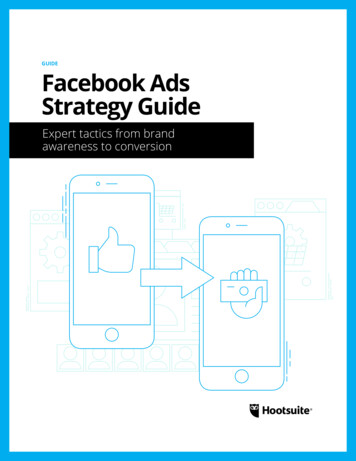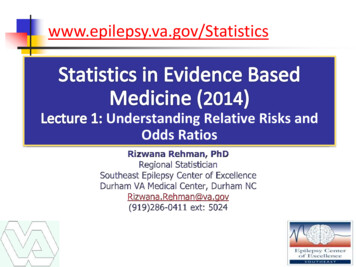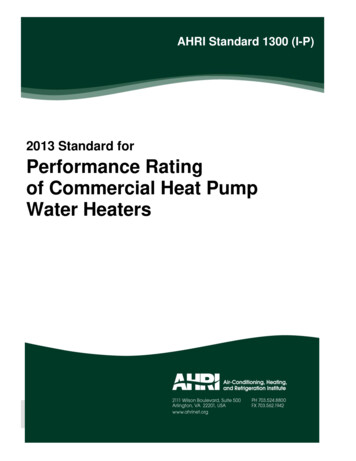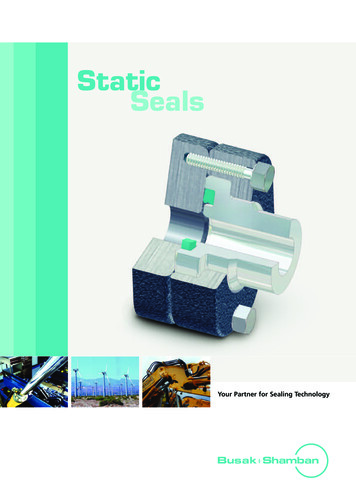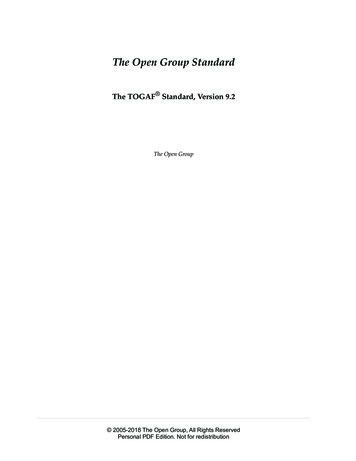
Transcription
The Open Group StandardThe TOGAF Standard, Version 9.2The Open Group 2005-2018 The Open Group, All Rights ReservedPersonal PDF Edition. Not for redistribution
Copyright 2005-2018, The Open GroupAll rights reserved.No part of this publication may be reproduced, stored in a retrieval system, or transmitted, in any form orby any means, electronic, mechanical, photocopying, recording or otherwise, without the priorpermission of the copyright owners.Any use of this publication for commercial purposes is subject to the terms of the Annual CommercialLicense relating to it. For further information, see www.opengroup.org/legal/licensing.The Open Group StandardThe TOGAF Standard, Version 9.2ISBN: 1-947754-11-9Document Number: C182Published in the U.S. by The Open Group, 2005-2018.Any comments relating to the material contained in this document may be submitted by email to:OGspecs@opengroup.orgiiThe Open Group Standard (2018) 2005-2018 The Open Group, All Rights ReservedPersonal PDF Edition. Not for redistribution
ContentsPartIIntroduction .1Chapter1Introduction 12.22.32.42.52.62.72.82.92.10Structure of this Document .Structure of the TOGAF Library.Executive Overview .Information on Using the TOGAF Standard .Conditions of Use .How Much Does the TOGAF Standard Cost? .Downloads.Why Join The Open Group? .Core Concepts .1111111112131516What is the TOGAF Standard? .What is Architecture in the Context of the TOGAF Standard? .What Kind of Architecture Does the TOGAF Standard Deal With? .Architecture Development Method .Deliverables, Artifacts, and Building Blocks .Enterprise Continuum .Architecture Repository .Establishing and Maintaining an Enterprise ArchitectureCapability .Establishing the Architecture Capability as an OperationalEntity .Using the TOGAF Standard with Other Frameworks .192018Chapter3Definitions .21PartIIArchitecture Development Method (ADM).35Chapter4Introduction to Part II .37374.14.1.14.1.24.1.34.24.2.1ADM Overview.The ADM, Enterprise Continuum, and ArchitectureRepository .The ADM and the Foundation Architecture .ADM and Supporting Guidelines and Techniques .Architecture Development Cycle .Key Points .The TOGAF Standard, Version 9.2 2005-2018 The Open Group, All Rights ReservedPersonal PDF Edition. Not for redistribution3738383939iii
3.46.3.5ivBasic Structure.Adapting the ADM.Architecture Governance .Scoping the Architecture .Breadth .Depth .Time Period.Architecture Domains .Architecture Integration .Summary.39424344454646474748Preliminary Phase .515252525253535454Objectives.Inputs.Reference Materials External to the Enterprise .Non-Architectural Inputs .Architectural Inputs .Steps.Scope the Enterprise Organizations Impacted .Confirm Governance and Support Frameworks .Define and Establish Enterprise Architecture Team andOrganization .Identify and Establish Architecture Principles .Tailor the TOGAF Framework and, if any, Other SelectedArchitecture Framework(s) .Develop a Strategy and Implementation Plan for Tools andTechniques .Outputs .Approach .Enterprise.Organizational Context.Requirements for Architecture Work .Principles .Management Frameworks .Relating the Management Frameworks .Planning for Enterprise Architecture/Business ChangeMaturity Evaluation .Phase A: Architecture Vision .Objectives.Inputs.Reference Materials External to the Enterprise .Non-Architectural Inputs .Architectural Inputs .Steps.Establish the Architecture Project .Identify Stakeholders, Concerns, and BusinessRequirements .Confirm and Elaborate Business Goals, Business Drivers,and Constraints .Evaluate Capabilities.Assess Readiness for Business Transformation 9The Open Group Standard (2018) 2005-2018 The Open Group, All Rights ReservedPersonal PDF Edition. Not for redistribution
.29.2.19.2.29.2.39.3Define Scope .Confirm and Elaborate Architecture Principles, includingBusiness Principles .Develop Architecture Vision .Define the Target Architecture Value Propositions andKPIs .Identify the Business Transformation Risks and MitigationActivities .Develop Statement of Architecture Work; Secure Approval .Outputs .Approach .General .Creating the Architecture Vision .Phase B: Business Architecture .Objectives.Inputs.Reference Materials External to the Enterprise .Non-Architectural Inputs .Architectural Inputs .Steps.Select Reference Models, Viewpoints, and Tools .Develop Baseline Business Architecture Description.Develop Target Business Architecture Description .Perform Gap Analysis.Define Candidate Roadmap Components .Resolve Impacts Across the Architecture Landscape .Conduct Formal Stakeholder Review.Finalize the Business Architecture .Create the Architecture Definition Document.Outputs .Approach .General .Developing the Baseline Description.Applying Business Capabilities.Applying Value Streams .Applying the Organization Map .Applying Modeling Techniques .Architecture Repository .Phase C: Information Systems Architectures .Objectives.Approach .Phase C: Information Systems Architectures — DataArchitecture .Objectives.Inputs.Reference Materials External to the Enterprise .Non-Architectural Inputs .Architectural Inputs .Steps.The TOGAF Standard, Version 9.2 2005-2018 The Open Group, All Rights ReservedPersonal PDF Edition. Not for 9799v
611.3.711.3.811.3.911.4viSelect Reference Models, Viewpoints, and Tools .Develop Baseline Data Architecture Description .Develop Target Data Architecture Description .Perform Gap Analysis.Define Candidate Roadmap Components .Resolve Impacts Across the Architecture Landscape .Conduct Formal Stakeholder Review.Finalize the Data Architecture .Create the Architecture Definition Document.Outputs .Approach .Key Considerations for Data Architecture.Architecture Repository .99102102103103103103104104104106106107Phase C: Information Systems Architectures — ApplicationArchitecture . 109Objectives.Inputs.Reference Materials External to the Enterprise .Non-Architectural Inputs .Architectural Inputs .Steps.Select Reference Models, Viewpoints, and Tools .Develop Baseline Application Architecture Description .Develop Target Application Architecture Description .Perform Gap Analysis.Define Candidate Roadmap Components .Resolve Impacts Across the Architecture Landscape .Conduct Formal Stakeholder Review.Finalize the Application Architecture.Create the Architecture Definition Document.Outputs .Approach .Architecture Repository 18118Phase D: Technology Architecture . 119Objectives.Inputs.Reference Materials External to the Enterprise .Non-Architectural Inputs .Architectural Inputs .Steps.Select Reference Models, Viewpoints, and Tools .Develop Baseline Technology Architecture Description .Develop Target Technology Architecture Description .Perform Gap Analysis.Define Candidate Roadmap Components .Resolve Impacts Across the Architecture Landscape .Conduct Formal Stakeholder Review.Finalize the Technology Architecture .Create the Architecture Definition Document.Outputs he Open Group Standard (2018) 2005-2018 The Open Group, All Rights ReservedPersonal PDF Edition. Not for redistribution
.413.3.513.3.613.3.713.413.5Chapter1414.1Approach . 129Emerging Technologies . 129Architecture Repository . 130Phase E: Opportunities & Solutions . 131Objectives.Inputs.Reference Materials External to the Enterprise .Non-Architectural Inputs .Architectural Inputs .Steps.Determine/Confirm Key Corporate Change Attributes .Determine Business Constraints for Implementation .Review and Consolidate Gap Analysis Results from Phases Bto D.Review Consolidated Requirements Across Related BusinessFunctions .Consolidate and Reconcile Interoperability Requirements .Refine and Validate Dependencies.Confirm Readiness and Risk for Business Transformation .Formulate Implementation and Migration Strategy .Identify and Group Major Work Packages .Identify Transition Architectures .Create the Architecture Roadmap & Implementation andMigration Plan .Outputs .Approach 37138139Phase F: Migration Planning . 141Objectives.Inputs.Reference Materials External to the Enterprise .Non-Architectural Inputs .Architectural Inputs .Steps.Confirm Management Framework Interactions for theImplementation and Migration Plan .Assign a Business Value to Each Work Package .Estimate Resource Requirements, Project Timings, andAvailability/Delivery Vehicle .Prioritize the Migration Projects through the Conduct ofa Cost/Benefit Assessment and Risk Validation .Confirm Architecture Roadmap and Update ArchitectureDefinition Document.Complete the Implementation and Migration Plan .Complete the Architecture Development Cycle and DocumentLessons Learned.Outputs .Approach e G: Implementation Governance. 149Objectives. 150The TOGAF Standard, Version 9.2 2005-2018 The Open Group, All Rights ReservedPersonal PDF Edition. Not for redistributionvii
.216.316.416.516.5.116.5.216.5.3Inputs.Reference Materials External to the Enterprise .Non-Architectural Inputs .Architectural Inputs .Steps.Confirm Scope and Priorities for Deployment withDevelopment Management.Identify Deployment Resources and Skills .Guide Development of Solutions Deployment .Perform Enterprise Architecture Compliance Reviews .Implement Business and IT Operations .Perform Post-Implementation Review and Close theImplementation .Outputs .Approach .150150150150151151152152153153153153154Phase H: Architecture Change Management. 155Objectives.Inputs.Reference Materials External to the Enterprise .Non-Architectural Inputs .Architectural Inputs .Steps.Establish Value Realization Process .Deploy Monitoring Tools.Manage Risks .Provide Analysis for Architecture Change Management.Develop Change Requirements to Meet Performance Targets .Manage Governance Process .Activate the Process to Implement Change .Outputs .Approach .Drivers for Change .Enterprise Architecture Change Management Process.Guidelines for Maintenance versus Architecture Redesign 62163ADM Architecture Requirements Management . 165Objectives.Inputs.Steps.Outputs .
The TOGAF Standard, Version 9.2 ISBN: 1-947754-11-9 Document Number: C182 Published in the U.S. by The Open Group, 2005-2018. Any comments relating to the material contained in this document may be submitted by email to: OGspecs@opengroup.org Any use of this publication for commercial


